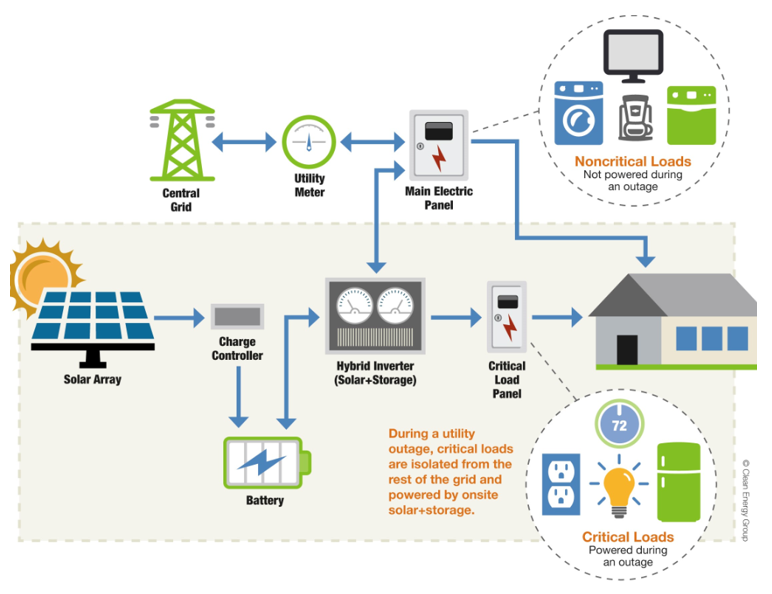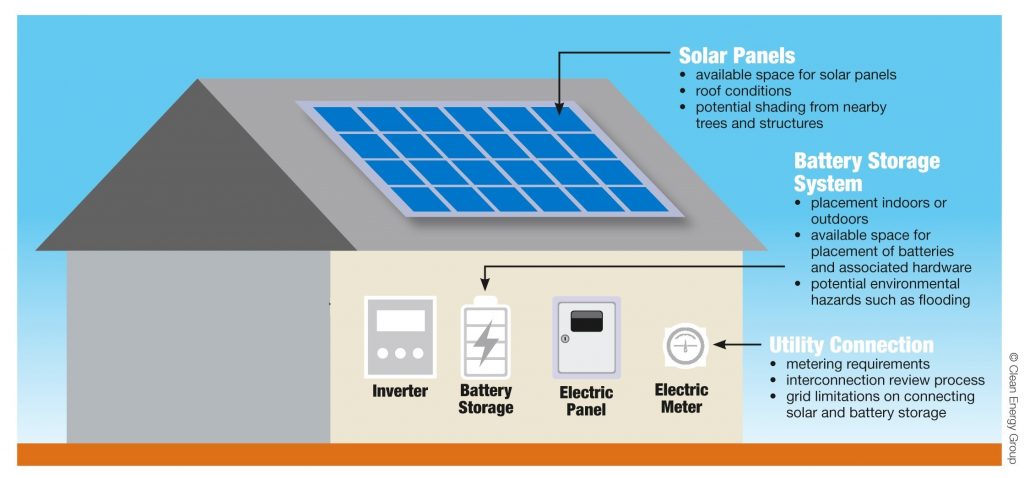
Energy storage technologies, such as batteries, can be paired with solar to provide emergency backup power during power outages, reduce electricity bills and benefit the grid.
Simply put, ‘solar plus storage’ is a battery system charged by a connected solar photovoltaic (PV) system. Solar panels only supply electricity when the sun is shining but demand for electricity fluctuates throughout the day. That’s why the ability to store solar energy for later use is important as it makes energy available to meet demand whenever needed, such as overnight or during a power outage. Likewise, storage batteries only provide energy till the battery runs out – in a grid outage, unless paired with a solar system, batteries cannot be recharged until grid power is restored.
A solar PV system without storage automatically shuts off during power outages to ensure that it does not “back feed” power onto the lines and injure repair crew. A solar plus storage system, also known as “resilient solar” also disconnects automatically from the grid during a power outage but continues to provide electricity. When the battery is drained, the system can resume delivering power when enough solar energy becomes available to recharge the battery.
Solar plus storage systems installed for backup power are typically tied into a critical load panel (a secondary panel next to your main electrical panel), that supplies power to your appliances which need to be powered during an outage. Critical loads vary by the function of the facility. For residential properties, these could include the refrigerator, furnace, lighting, medical devices, electric well pumps, etc. For businesses, these could include mission-critical operations which would decrease losses in the case of a power interruption.

As an example of how solar plus storage can support critical functions, the City of Toronto has installed a 10kW solar PV system with 27kWh of storage batteries at one of its EMS stations to power the building’s critical loads for a minimum of 20 hours from stored energy alone, and indefinitely with solar energy.
Smaller storage systems can be used for residential and small commercial properties to enhance solar PV systems and provide emergency backup power as an alternative to, or in addition to, diesel or gas generators (gensets). Users can also utilize these systems for energy arbitrage i.e., charging storage when costs are low and discharging for use when costs are higher, for savings or to increase solar self-consumption.
ICI facilities commonly use medium to large systems for peak load/demand management and emergency backup power. Larger electric consumers specifically pay a large portion of their energy bills to Global Adjustment (GA) charges, which can be reduced with energy storage.
The Independent Electricity System Operator’s (IESO) Industrial Conservation Initiative (ICI) is a demand-response program aimed at shifting large electricity users’ consumption to off-peak hours. The GA charges of participating customers are based on their contribution to Ontario’s load during the top five peak hours of annual energy consumption. Five hours of peak demand per year can represent up to 60 per cent of their electricity bill. Storage can be programmed to reduce these charges by charging in off-peak hours and then discharging stored energy to meet consumption during peak hours. Refer to IESO for more information.
There are many benefits to choosing energy storage, depending on the application.
Provide power to critical loads in your home or business during grid outages. Unlike diesel, propane or gas generators, solar plus storage does not require you to buy and store fuel, or rely on fuel delivery during an outage. It does not emit greenhouse gases (GHG) or noise and it does not require regular maintenance. In the event of a multiple-day power outage, a facility with solar plus storage will charge the battery during the day and use the stored energy at night. With an appropriate load design and sufficient sunlight, this cycle should repeat each day.
Solar and storage can reduce your reliance on the power grid. With a battery, you can use more solar energy by storing the excess solar energy and using it at night. Depending on the cost and required size of the battery, homeowners could even self-power their home by running it exclusively on solar and battery.
Instead of paying higher utility rates for energy usage during peak time-of-use (TOU) hours, you can reduce energy costs by charging batteries from solar, in addition to charging from the grid during off-peak times and discharging into the grid during on-peak times to maximize net metering credits. (With net metering, every unit of electricity you feed into the grid from your solar PV system is credited as one unit of electricity, which can be drawn from the grid at any time).
As the use of battery storage rises, it takes pressure off the electricity grid, which reduces the need for additional electrical infrastructure and costly upgrades. Storage can also provide ancillary services such as frequency and voltage regulation, which improve grid stability.
Purchasing a battery system is a complex decision. There are several factors that should be considered. To learn more about whether a battery system is right for you, read through the sections below.
Clearly outline the need and your reasons for pursuing storage: is it to partially or fully backup home loads or to utilize energy arbitrage, for savings or increase solar self-consumption. Once you have decided, you need to understand the financial cost and benefit. The cost of a battery system would depend on the capacity needed and variables related to your specific installation. It is important to note that although resiliency from backup power cannot be monetized, it offers substantial value.
Refer to our Solar Directory to find vendors and quotes for a battery system on your property.
A battery’s chemistry refers to the primary material used to store electricity. The most used types are lithium-ion and lead acid batteries. The chemistry of a battery determines most of its characteristics, such as the energy capacity and power rating listed below.
The size of the battery system will depend on how it will be used over time. Sizing a system for backup power versus managing energy demand is a very different process. There are two key characteristics that determine the size and duration of a battery:
Look at the power and energy capacity ratings together when selecting a battery. If you have a high-capacity battery with a low power rating, you can power a few appliances for longer. A battery with a high-power rating but a low storage capacity will power more appliances for a shorter amount of time.
Roundtrip efficiency measures how well your battery system converts and stores electricity. For example, if solar panels sent 10 kWh of electricity to the battery, but only 7 kWh of that electricity was stored, the round-trip efficiency of your battery would be 70 per cent. The higher the roundtrip efficiency, the less energy is lost in the storage process.
The useful lifespan of a battery system is defined by how long the batteries last before they degrade and are unable to effectively serve their intended purpose. Lifespan depends on the battery chemistry and how the battery is operated. For instance, a lead acid battery, cycled (charged and discharged) once a day may last for two years, whereas a lithium-ion battery could last more than 15 years. Lithium-ion warranties are typically ten years with 70-80 per cent available capacity at the end of the warranty period, while lead acid battery warranties range from two to five years.
Battery systems are generally considered safe but require some precautions. For example, certain lead acid batteries require outside ventilation to avoid flammable and smelly off-gassing, and lithium-ion batteries can overheat if improperly installed or maintained. Preventative maintenance and monitoring are recommended. Inquire about the safety of each proposed battery with your installer.
Battery systems are expected to become more affordable as technology advances. Based on most residential utility rates, energy storage does not significantly reduce the utility bill enough to pay for itself before the end of its warranty period. The main reason for battery storage for homes and smaller buildings continues to be back up power.
The federal government and the City of Toronto offer incentives for storage systems. For more information refer to the Financing & Incentives section.
It is also important to consider any physical or structural barriers that might limit the size and configuration of the system, local permitting and safety requirements, and Toronto Hydro’s interconnection procedures. These factors can affect the cost and feasibility of your project.

If you are installing solar PV but cannot afford batteries, you could consider a “battery-ready” design to accommodate the installation of battery storage in the future. The selection of the inverter would depend on its ability to integrate with the future battery, and adequate space would need to be allotted for the battery. Systems that intend to add storage for backup power should identify and isolate essential loads in a critical load panel and install a transfer switch. If a storage-ready design is not considered when installing a solar system, adding storage in the future can become more complex and costly.
Solar, storage and electric vehicles (EVs) each deliver valuable benefits to users and the grid, but the combination of these technologies can result in value above and beyond the sum of their individual benefits.
EVs have lower fuel costs, require less maintenance and have a smaller carbon footprint compared to internal combustion engine vehicles. Electricity users on a Time of Use schedule can benefit from lower prices for vehicle charging during off-peak hours. Refer to the City’s Electric Vehicles webpage to learn more about the benefits of EVs.
Although an EV user would achieve substantial savings by eliminating their gasoline or diesel costs, their electricity bills would increase from charging the vehicle. When purchasing an EV, homeowners can consider pairing it with solar and storage to offset their electricity consumption, thereby reducing their energy bills and protecting themselves from rising electricity costs.
The average lifespan of solar panels is 25 to 30 years, meaning that the solar panels will continue to provide free electricity for decades longer than the lifetime of a single EV and will continue to fuel subsequent EVs.
Pairing your solar panels with EV charging can pay off faster than only using them for home use as the power replaces more expensive gasoline and electricity from the grid.
An emerging technology provided by some EV companies is “vehicle-to–grid,” or V2G, which allows you to take the electricity stored in your EV’s battery and use it to power your home or send it back to the grid. Given that an EV’s battery is much larger than a standard home battery, V2G could allow you to back up more loads aside from critical loads, providing more financial benefit for solar users on a time-of-use (TOU) utility schedule.